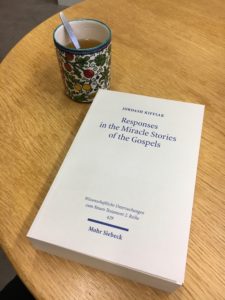Are the frequent depictions of characters’ responses to the various miraculous occurrences in the Gospels merely vestiges from an earlier stage in the developments of the traditions about Jesus? Do the responses function simply as a round of applause to commend Jesus to those hearing a given gospel being read? Or is this response motif a device capable of taking on varied hues and serving diverse, even complex purposes? This is the first set of questions that my recently published monograph, Responses in the Miracle Stories of the Gospels: Between Artistry and Inherited Tradition, sets out to answer.[1]
An enormous amount of scholarly attention has been devoted to the miracle stories in the New Testament over the past hundred years, without any sign of the interest abating, as attested by numerous edited volumes published on the topic in the past five years alone.[2] Moreover, beginning already with Martin Dibelius and Rudolf Bultmann, the importance of the frequent descriptions of various individuals’ and groups’ responses as a distinctive part of gospel miracle stories has been acknowledged. Yet, remarkably, prior to the publication of Responses in the Miracle Stories of the Gospels, there had been no focused study of the responses.
In this blog post I will summarize my findings on the questions raised above, which I investigate in the book’s first part, “Towards Artistry.” (The book’s second part, “Towards Tradition,” investigates features of responses shared by the Four Gospels, with implications for the interrelations of the Gospels as well as for the potential influence of oral tradition in the formation of the Jesus tradition. I will discuss the second part in a further blog post.)
I adopt definitions that facilitate an analysis of the literary features in question that is most comprehensive. The group of stories I study is broadly conceived, because by “miracle” I mean not only mighty deeds, such as healings and exorcisms, but also epiphanies, namely appearances of God, angels and also Jesus, when portrayed as more-than-human. (The appropriateness of this approach is in turn affirmed by the analysis of each gospel.) For “response,” I adopt a definition that both is more comprehensive than previous approaches and focuses more on formal aspects, allowing for a determination of a response’s quality based on factors beyond the immediate sentence(s) in question. A response is: a clause (or series of contiguous clauses) that describe one or more characters’ visual perception and/or internalized and/or externalized experience occurring after a miracle. This basic definition covers the vast majority of instances studied, while some flexibility is allowed, whereby certain literary features – notably three lengthy, complex responses in John, involving interaction between characters – can be taken as variations on a familiar theme.
Each of four chapters provides a literary analysis of a particular gospel, on its own terms, to determine the roles that responses play both in the respective miracle stories and in the gospel in question, when taken as a whole. I will summarize my analyses of Mark and John here and comment on a few points from my analyses of Matthew and Luke.
Mark
In the Gospel of Mark, stories of miracles and descriptions of characters responses to them have an important role in the larger, unravelling narrative. Though the various characters’ responses to the miraculous draw on a common body of components – feelings, visual sensation, cognition, verbal utterances, movement to other locations and reporting to others – they function in a variety of capacities. (The fact that responses in epiphanic and non-epiphanic miracle stories draw on a common, limited pool of elements is one factor supporting the more inclusive definition of miracle story.) The diversity of function is relevant to both characterization and plot.
I begin with the former. First, in terms of the respondents, the responses rarely serve to paint a few characters in broad strokes, whether negatively (e.g. the Pharisees) or positively (e.g. Bartimaeus). More commonly they help bring about a complicated picture. For example, amazement at Jesus’ teaching and miracle-working power, exclamations’ singing Jesus’ praise and so forth, naturally have a positive aspect. Yet these responses are often undermined by other aspects of the stories in question, as when an evil spirit’s understanding of Jesus’ identity surpasses that expressed by an amazed crowd in Capernaum. Alternatively, the fame achieved for Jesus through a healed man’s response stems in fact from the respondent’s recalcitrant behavior. The disciples’ fear and verbal exuberance about Jesus’ power is tempered by the narrator’s explicit comment about their ignorance. Characters’ responses to miracles in Mark are presented primarily in terms of the degree of their comprehension and acceptance of the narrator’s understanding of Jesus. The various responses constantly fail to meet the standards set in the narrative’s opening scene, where the divine voice recognizes Jesus as his beloved son.
A second, related point regards how the responses affect the characterization of the miracle worker or the epiphanic character. In part, Jesus is characterized positively on account of the acclamation, amazement, reporting and so forth that respondents engage in. Commonly, however, it is more through the limited understanding of the respondents, that the contours of the figure of Jesus are drawn. Jesus is repeatedly presented as a figure whose identify – known already to the readers and hearers of the text – is superior to other characters’ conceptions of him.
The functional diversity of characters’ responses pertains also to the plot of Mark, greatly informed by miracle stories, which centers on depicting what it means for Jesus to be God’s son.[3] A related, subplot-line pertains to which characters might attain this understanding and when, a set of questions raised in the opening epiphany story, where no character responds to the heavenly voice’s designation of Jesus as God’s son. The unfolding narrative maps out a spectrum of negative to positive estimations of Jesus. Especially the story’s first half, replete with miracle stories, uses the response motif as a significant means for this mapping. All characters fail, some in a manner worse than others.
Miracle stories are sharply divided into two groups of unequal size. A series of four stories – namely, the stilling of the storm, the walking on the water, the transfiguration and the resurrection-related angelophany – are interspersed among the other miracle stories. Here the setting is consistently private and miracles of an epiphanic nature are involved, giving characters a privileged glimpse at the true extent of Jesus’ great power and nature. Established followers of Jesus alone respond, with the response always having an affective element of fear or being troubled. Moreover, each story employs a non-standard focalization (i.e. the narrator is not the [sole] focalizer, but [also] the disciples or Jesus), a form of narration that is rare in this text. These respondents come the closest to understanding who Jesus is, but their comprehension still falls significantly short of the mark.
The second, larger group of miracle stories differs in terms of setting (public or moving from private to public), miracle type (less remarkable miracles, especially healings and exorcisms), respondents (those other than Jesus’ established followers), focalization (consistent narrator-focalizer) and, where present, the affective aspect of the response. For the last point both intensity and kind of feeling is in view. When the response portrays a feeling, amazement is characteristically involved, in contrast to the more intense fear that arises in the epiphanic episodes – the distinction between these affective responses has not been noted in previous scholarship.[4] Typically, respondents in these stories express a limited appreciation of Jesus. At worst, a response is unwelcoming or even hostile and leading towards violence.
The employment of these stories and the respective responses in the course of the developing narrative serves to further the main plot-line and a subplot-line of conflict between Jesus and his disciples. The series of three private, epiphanic miracles for Jesus’ core followers, interspersed among the stories of healings and exorcisms, grow in the level of power displayed and the exclusivity of the setting. The stories build to crescendo, reached at the story’s turning point. In the transfiguration, the narrator uncovers for the gospel’s readers and hearers the powerful, glorious aspect of Jesus’ nature to its fullest extent. But the followers do not comprehend. Their misguided response elicits correction from the heavenly voice, now revealing to them that Jesus is God’s son, recalling the key revelation, made in the opening story. Yet the subsequent description of them merely seeing Jesus, without further response, betrays their lack of understanding, raising the level of tension.
The resolution of the main plot-line is achieved at Jesus’ crucifixion – where the second defining aspect of Jesus’ nature, the suffering servant of all is disclosed – as his execution ironically states that the man crucified is the son of God. Two subplot-lines, however, are held in suspense right up to the narrative’s end (as known from the earliest manuscripts). The relevant questions – “which characters will recognize who Jesus is?” and “will the followers of Jesus be faithful to his call of discipleship?” – are addressed by Mary, Mary and Salome’s fearful response of flight and silence to the angel’s appearance at the tomb. Through the final, unsatisfactory response of Jesus’ established followers in a privileged epiphany, the narrator invites the hearers and readers: to believe that God will eventually accomplish God’s purposes, despite Jesus’ followers’ weaknesses, and also, possibly, to take up the task of telling others about Jesus’ resurrection.
John
Miracles stories in John, which all contain responses, serve the plot in two important ways. They portray the development of belief in Jesus, or lack thereof, through various characters’ encounters with Jesus. Characterization is, thus, very closely related to plot here. The stories also point forward to, alternatively backward to, Jesus’ death and resurrection, infusing these eschatological events with meaning.[5] Responses play a notable role in both regards. As for characterization, when responses depict faith, it is typically a level of belief that has grown as the events in question progress. It should be noted that the sign stories – eleven in my reading – include not just the initial seven stories occurring in the first half of the narrative, but also the four post-resurrection episodes in which Jesus appears to one or more disciples.
Beginning with Jesus’ initial call of a few disciples, the narrative develops as Jesus encounters various individuals and groups, who display a variety of levels of belief in him. In their response to the opening sign, the turning of water to wine, the already burgeoning faith of the first followers, begun in their conversations with Jesus, grows further. Though belief language is explicitly used in the responses both here and in the following sign story, both of which are articulated briefly, later responses will typically depict the presence or absence of belief by other means. In the first miracle story, the disciples’ belief in Jesus is connected to the imminent hour in which he will be glorified, anticipating the eschatological events of Jesus’ death and resurrection and resultant benefits that will then inspire a yet superior faith.
Following a conversation with the socially privileged Jewish Nicodemus, which fails to inspire faith, and another one with the socially disadvantaged Samaritan woman, which succeeds, Jesus’ second sign, a healing, brings the extant faith of a royal official in the Galilee to a greater depth. In the third sign story, a watershed episode, sees the first negative use of the response motif. Following the healing of the incapacitated man at the pool of Bethesda, the recipient’s ambiguous response serves to endanger Jesus, exposing him to his opponents. Their response, seeking to kill Jesus, is more blatantly unsatisfactory. The response motif is here stretched substantially beyond its typical formal composition, as the actions of these two respondents, an individual and a group, are developed through a series of interactions between not only them, but also them and Jesus. That the story ends with what is effectively a monologue by Jesus, as did the episode with Nicodemus, seals the picture of failure to believe.
Even seemingly positive responses can express something other than adequate belief. The crowd’s proclamation that Jesus is a great prophet following a spectacular provision of food is thoroughly undermined, both by Jesus’ uncanny awareness of their inappropriate assessment of him and wrong intentions and by later dialogue which exposes these shortcomings. When Jesus, walking on the water, reveals himself by saying “I am,” the disciples fail to grasp the significance of what is being done and said. (Though Jesus’ speech is for the present ambiguous, the phrase “I am,” which first appears here, will later be invested with meaning.) The disciples’ fearful response upon seeing this epiphany of Jesus is followed by a lack of appreciation of Jesus’ self-revelation. The absence of a response at the episode’s end indicates that their faith has not developed in response to the miraculous happening as it ought to have.
The healing from blindness, like the earlier healing at Bethesda, is followed by a complex response, involving the actions of numerous characters, interacting with one another and with Jesus. The healed man’s development in faith is brought to a peak, with a literary feature that recalls the shorter responses from earlier episodes, when he expresses a well-developed belief in Jesus, indicated through his prostration and verbal confession of faith. Various points connecting the story here to the last episode of healing, further demonstrate the inferiority of the incapacitated man’s response there. The other main respondents here, the religious authorities, again respond with hostility. An extended speech from Jesus again occupies the latter part of the story. Freedom from physical blindness pertains also to a soon-coming eschatological gift, by which characters and the hearers and readers of John will be able to recognize Jesus for who he truly is.
In a twist of convention, Martha articulates, prior to the resurrection of Lazarus, a pronounced expression of faith in Jesus. The resurrection itself leads to some Judeans believing in him, though others report on him to the Pharisees. As in chapters five and nine, a lengthy response involves multiple characters and interactions. It culminates in a decision by the religious authorities to kill Jesus. Thus, the initial seven sign stories come to a close, pointing forward to the imminent eschatological moment of Jesus’ passion and resurrection.
Subsequent to Jesus’ resurrection a series of three encounters between his followers and him occurs. Like the similar series of encounters at the narrative’s opening, the occurrences here build on each other. Martha reports to the other disciples that she has seen “the Lord,” just as they then in turn provide Thomas with a similar, faith-filled report. The culminating moment, when one previously skeptical becomes the mouthpiece of the greatest statement about Jesus in the Fourth Gospel, Thomas proclaims Jesus to be his Lord and his God, while seeing the crucified and risen one. (In the narrative’s dénouement, where Jesus interacts with his disciples in the Galilee, the response motif plays just a secondary role.)
Matthew and Luke
I can give here only a brief sampling from the results of the analyses of Matthew and Luke. One point of interest is in Matthew’s opening sequence of appearances of the Angel of the Lord, where Joseph’s responses, repeatedly exhibiting verbal parallelism with the angelic commands, underscore that God’s plan will be accomplished despite human and diabolical resistance and machinations. Given the primacy effect, one can expect a victory from God in the overall plot, despite whatever complications will arise. Alternatively, the inadequacy of a response can catch the readers and hearers of the Gospel by surprise. Thus, the disciples’ prostration in the boat before Jesus and proclamation “You are truly the son of God” is later revealed as inadequate. Since later, at Jesus’ transfiguration, a voice from heaven has to articulate this same message to an exclusive group of disciples, despite their being privy to an extraordinary revelation of Jesus, the shallowness of the understanding laying behind the disciples’ earlier proclamation is exposed.
In Luke, responses involving praise are best appreciated when understood within the larger, unfolding narrative. They are more complex than has usually been observed. The Pharisees’ praise-filled response to the paralytic’s healing and later a crowd’s more impassioned praise and commendation of Jesus are undermined, respectively, by the Pharisees antagonistic response to a later healing and Jesus’ chastisement of Galilean towns in this generation who have not responded with repentance at the mighty deeds he has performed. Towards the climax of the narrative, the series of post-resurrection appearances – first of an angel, then of Jesus – help to peel away the layers of the disciples’ misunderstanding und unbelief about the necessity of Jesus’ suffering and death to fulfil God’s plan. The responses in these miracle stories serve to depict an important part of this process of enlightenment.
Interestingly, both Matthew and Luke contain versions of a miracle story in which the response motif is creatively inverted. Jesus’ reaction to the Capernaum centurion’s expression of faith – prior to the accomplishment of the healing – involves amazement and speech, very much like the amazed, verbal responses to miracles occurring in other stories. The twist in use of the convention serves to further underscore the remarkable faith in Jesus exhibited by this Gentile petitioner.
What’s coming up next time?
In the next blog post, I will summarize the book’s lengthy analysis of responses as they shed light on the interrelations of the Gospels – the Synoptic Problem in particular, but also all four of the Gospels taken together – including the role oral tradition may play. I will then relate the findings of the book’s concluding, preliminary analysis of the traditional influences on the gospel miracle stories, paying special attention to the differences between ancient Jewish and non-Jewish stories about the miraculous.
Jordash Kiffiak is working on a postdoctoral project (Forschungskredit) at the University of Zurich with Prof. Jörg Frey, investigating whether Jewish or non-Jewish miracle stories provide a better context for understanding the response motif found in the Gospels (Responses to Miracles in Jewish and Non-Jewish Narratives). Since 2007 he has taught ancient languages – biblical Hebrew, Syriac and, especially, Hellenistic Greek – using innovative, communicative approaches at various institutes, including the University of Zurich.
Footnotes
[1] The book, a revised and enlarged version of my doctoral dissertation, supervised by Serge Ruzer and Loren Stuckenbruck and accepted by the Hebrew University in July 2015, was printed as volume 429 in Mohr Siebeck’s WUNT II series earlier this year.
[2] D. F. Watson, ed., Miracle Discourse in the New Testament (Atlanta, Ga.: SBL, 2012); S. Alkier and A. Weissenrieder, eds., Miracles Revisited: New Testament Miracle Stories and Their Concepts of Reality, SBR, 2 (Berlin: De Gruyter, 2013); T. Nicklas and J. E. Spittler, eds., Credible, Incredible: The Miraculous in the Ancient Mediterranean, WUNT I, 321 (Tübingen: Mohr Siebeck, 2013); R. Zimmermann (ed.), Kompendium der frühchristlichen Wundererzählungen, Band 1: Die Wunder Jesu, in collaboration with D. Dormeyer, J. Hartenstein, C. Münch, E. E. Popkes and U. Poplutz (Gütersloh: Gütersloher Verlagshaus, 2013); B. Kollmann and R. Zimmermann, eds., Hermeneutik der frühchristlichen Wundererzählungen: Geschichtliche, literarische und rezeptionsorientierte Perspektiven, WUNT I, 339 (Tübingen: Mohr Siebeck, 2014).
[3] My conception of the plot of Mark adopts, along broad lines, that articulated by R. Alan Culpepper, Mark, SHBS, 20 (Macon, Ga.: Smyth and Helwys, 2007), 18–19, 49.
[4] The difference in affective responses in the two groups of stories is particularly noteworthy, as feelings are the most characteristic component of responses in Mark, both quantitatively and qualitatively (in terms of prominence in the discourse). For further discussion of the semantic distinction in Greek between terminology referring to fear and amazement, see my essay “Amazement, Fear and Being Troubled in Responses in Gospel Miracle Stories: Establishing the Semantic Contours of the Terms and Their Interrelations” in From Ancient Manuscripts to Modern Dictionaries: Select Studies in Aramaic, Hebrew, and Greek, Perspectives on Linguistics and Ancient Languages (eds. Tarsee Li and Keith Dyer; Piscataway, New Jersey: Gorgias, 2017).
[5] My conception of the plot of John relies on the work of R. Alan Culpepper, Anatomy of the Fourth Gospel: A Study in Literary Design, Foundations and Facets (Philadelphia: Fortress, 1983), with important modifications based on insights from Francis J. Moloney, The Gospel of John, SP, 4 (Collegeville, Minn.: Liturgical, 1998) and Jörg Frey, Die Herrlichkeit des Gekreuzigten: Studien zu den johanneischen Schriften 1, ed. Juliane Schlegel, WUNT I, 307 (Tübingen: Mohr Siebeck, 2013).







2 Kommentare vorhanden
1 Characters’ Responses to Miracles in the Gospels (Part 2) // Sep 11, 2017 at 13:46
[…] contribution made by the first portion of the book, entitled “Towards Artistry,” in an earlier post. The analysis there makes it clear that the motif in question – descriptions of characters’ […]
2 Book Reviews // Jun 15, 2018 at 15:08
[…] more about the book here and […]
Kommentar schreiben